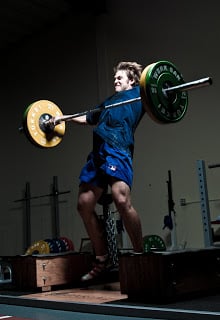
It is always interesting to see the long, tedious process of learning the Olympic lifts, whether it is implementing a complicated teaching progression or using extremely light objects, such as a dowel. It is no wonder why so many programs abandon the pursuit of these lifts; either they take too long to learn or the light movements provide such a small strength/speed stimulus.
However, these Olympic lifts are some of the most efficient means of providing athletes with more power. There is good news in that their proficiency can be dramatically expedited by being more comfortable in the catch position, which refers to the receiving portion after the pull of the weighted barbell from the hang or floor. This catch aspect is the most important part of the lift. After all you would not teach someone how to skydive without first instructing them how to pull their parachute.
Like many of our posts, you guessed it; this catch position essentially refers to the squat. So if you’re learning how to clean, but only perform back squat, you will never fully appreciate the position of a front squat, the catch after the pull portion of a clean. In fact, Olympic lifting coaches often expect athletes to front squat at least 20% more than their clean. After working at several major universities, I can guarantee that this lift to “catch” ratio is rarely the case.
Perhaps more concerning is the snatch, where athletes must pull the bar overhead, requiring the catch portion to be an overhead squat. The overhead squat is a major component of the Functional Movement Screen and provides an excellent assessment tool. Unfortunately, this screen is performed with a dowel so 20% more than this weight would equate to what…a heavier dowel. If you’re looking to improve your snatch performance, and therefore your resulting speed and power, efforts would be better spent on strengthening the overhead catch position first. Overhead squat variations and snatch press are some of the more relevant exercises to improve the receiving aspect of this lift.
The perfection of this catch position, specifically front and overhead squat, are generally abandoned or limited due to athletes’ flexibility needs. Baseball players are too tight in the forearms from the pursuit of big arms, football players can’t put the same weight as back squat, and female players cannot squat deep because it bothers their knees. This need for squatting presents an excellent opportunity to simultaneously improve flexibility, strength, and improve Olympic lifting technique without wasting excessive time on long teaching progressions and lighter weights.
In a decade of coaching, I have never found any athlete that takes longer than 15 minutes to learn how to Olympic lift, mostly because the last few weeks were spent perfecting the squat. It doesn’t take much effort to jump out of the plane, as long as you know how to land.